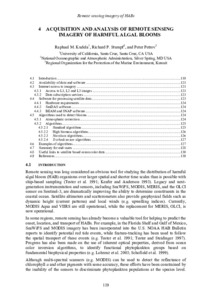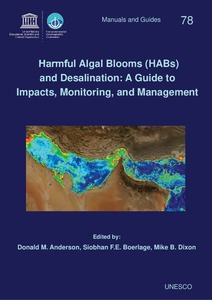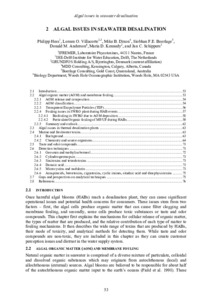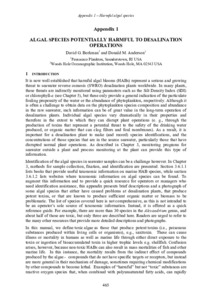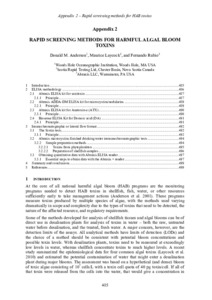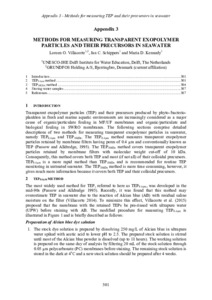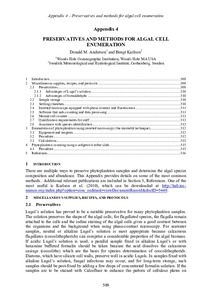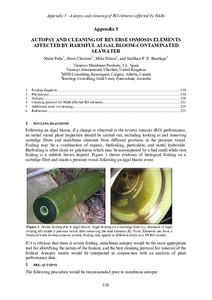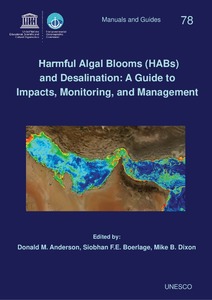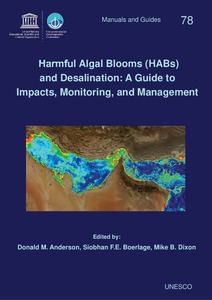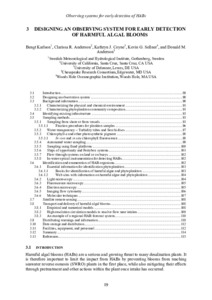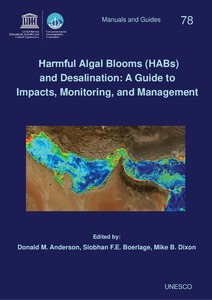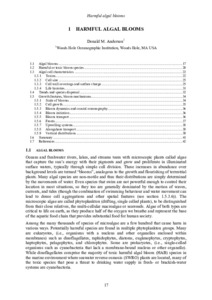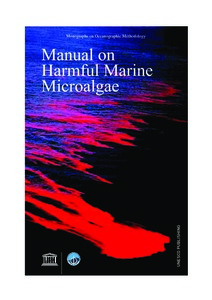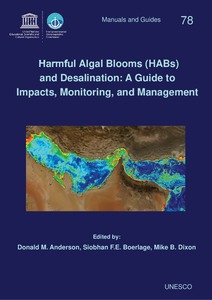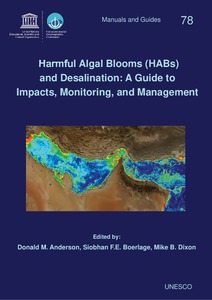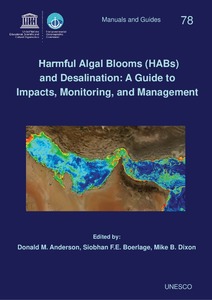Browsing HAB by Author "Anderson, D.M."
Now showing items 1-17 of 17
-
Acquisition and analysis of remote sensing imagery of harmful algal blooms.
Kudela, Raphael M.; Stumpf, Richard P.; Petrov, Peter (Intergovernmental Oceanographic Commission of UNESCO, Paris, France, 2017)Remote sensing was long considered an obvious tool for studying the distribution of harmful algal bloom (HAB) organisms over larger spatial and shorter time scales than is possible with ship-based sampling (Tester et al. ... -
Algal biomass pretreatment in Seawater Reverse Osmosis.
Dixon, Mike B.; Boerlage, Siobhan F.E.; Voutchkov, Nikolay; Henderson, Rita; Wilf, Mark; Zhu, Ivan; Assiyeh Alizadeh Tabatabai, S.; Amato, Tony; Resosudarmo, Adhikara; Pearce, Graeme K.; Kennedy, Maria; Schippers, Jan C.; Winters, Harvey (Intergovernmental Oceanographic Commission of UNESCO, Paris, France, 2017)Harmful algal blooms (HABs) can result in a substantial increase in the organic and solids load in the seawater feed to be treated at a desalination plant. In this chapter, the removal of this material is addressed in ... -
Algal issues in seawater desalination.
Hess, Philipp; Villacorte, Loreen O.; Dixon, Mike B.; Boerlage, Siobhan F.E.; Anderson, Donald M.; Kennedy, Maria D.; Schippers, Jan C. (Intergovernmental Oceanographic Commission of UNESCO, Paris, France, 2017)Once harmful algal blooms (HABs) reach a desalination plant, they can cause significant operational issues and potential health concerns for consumers. These issues stem from two factors – first, the algal cells produce ... -
Appendix 1. Algal species potentially harmful to desalinitation operations.
Borkman, David G.; Anderson, Donald M. (Intergovernmental Oceanographic Commission of UNESCO, Paris, France, 2017)It is now well established that harmful algal blooms (HABs) represent a serious and growing threat to seawater reverse osmosis (SWRO) desalination plants worldwide. In many plants, these threats are indirectly monitored ... -
Appendix 2. Rapid screening methods for Harmful Algal Blooms toxins.
Anderson, Donald M.; Laycock, Maurice; Rubio, Fernando (Intergovernmental Oceanographic Commission of UNESCO, Paris, France, 2017)At the core of all national harmful algal bloom (HAB) programs are the monitoring programs needed to detect HAB toxins in shellfish, fish, water, or other resources sufficiently early to take management actions (Anderson ... -
Appendix 3. Methods for measuring transparent exopolymer particles and their precursors in seawater.
Villacorte, Loreen O.; Schippers, Jan C.; Kennedy, Maria D. (Intergovernmental Oceanographic Commission of UNESCO, Paris, France, 2017)Transparent exopolymer particles (TEP) and their precursors produced by phyto-/bacterioplankton in fresh and marine aquatic environments are increasingly considered as a major cause of organic/particulate fouling in MF/UF ... -
Appendix 4. Preservatives and methods for algal cell enumeration.
Anderson, Donald M.; Karlson, Bengt (Intergovernmental Oceanographic Commission of UNESCO, Paris, France, 2017)There are multiple ways to preserve phytoplankton samples and determine the algal species composition and abundance. This Appendix provides details on some of the most common methods. Additional relevant publications are ... -
Appendix 5. Autopsy and cleaning of reverse osmosis elements affected by harmful algal bloom-contaminated seawater.
Peña, Nuria; Chesters, Steve; Dixon, Mike B.; Boerlage, Siobhan F. E. (Intergovernmental Oceanographic Commission of UNESCO, Paris, France, 2017)Following an algal bloom, if a change is observed in the reverse osmosis (RO) performance, an initial visual plant inspection should be carried out, including looking at and removing cartridge filters and membrane elements ... -
Bloom prevention and control.
Anderson, Clarissa R.; Sellner, Kevin G.; Anderson, Donald M. (Intergovernmental Oceanographic Commission of UNESCO, Paris, France, 2017)Harmful algal blooms (HABs) are a serious and growing problem to many sectors of society, including the desalination industry. The many problems that HABs present for seawater reverse osmosis (SWRO) desalination plants ... -
Case histories for Harmful Algal Blooms in desalination.
Boerlage, Siobhan F.E.; Dixon, Mike B.; Anderson, Donald M. (Intergovernmental Oceanographic Commission of UNESCO, Paris, France, 2017)Algae have long been an issue impacting desalination plant operation in areas prone to algal blooms or where macroalgae (seaweeds) and detritus became dislodged from the seabed. Previously and still today, operators and ... -
Designing an observing system for early detection of harmful algal blooms.
Karlson, Bengt; Anderson, Clarissa R.; Coyne, Kathryn J.; Sellner, Kevin G.; Anderson, Donald M. (Intergovernmental Oceanographic Commission of UNESCO, Paris, France, 2017)Harmful algal blooms (HABs) are a serious and growing threat to many desalination plants. It is therefore important to limit the impact from HABs by preventing blooms from reaching seawater reverse osmosis (SWRO) plants ... -
Harmful agal bloom-related water quality monitoring for desalination design and operation.
Boerlage, Siobhan F.E.; Villacorte, Loreen O.; Weinrich, Lauren; Assiyeh Alizadeh Tabatabai, S.; Kennedy, Maria D.; Schippers, Jan C. (Intergovernmental Oceanographic Commission of UNESCO, Paris, France, 2017)Characterization of the raw seawater at plant intakes and monitoring to detect poor water quality events including harmful algal blooms (HABs) is critical throughout the lifetime of a desalination plant. HABs can result ... -
Harmful algal blooms.
Anderson, Donald M. (Intergovernmental Oceanographic Commission of UNESCO, Paris, France, 2017)Harmful algal blooms are increasing in frequency and magnitude in many parts of the world, and one of the sectors of society that is being increasingly affected is the desalination industry. Given trends in the development ... -
Manual on Harmful Marine Microalgae. 2nd revised edition.
Hallegraeff, G.M.; Anderson, D.M.; Cembella, A.D.; Enevoldsen, H.O. (UNESCO, Paris, France, 2004)Following a general introduction on harmful algal blooms, the Manual proper is composed of four parts: Methods, Taxonomy, Monitoring and Management, and Appendices. The Methods section covers oceanographic field-sampling ... -
Removal of algal toxins and taste and odor compounds during desalination.
Dixon, Mike B.; Boerlage, Siobhan F.E.; Churman, Holly; Henthorne, Lisa; Anderson, Donald M. (Intergovernmental Oceanographic Commission of UNESCO, Paris, France, 2017)A major challenge in desalination is the removal of harmful algal bloom (HAB) toxins and taste and odor compounds (hereafter referred to as algal metabolites) using common treatment techniques. Removal of other compounds ... -
Seawater intake considerations to mitigate HAB impacts.
Boerlage, Siobhan F.E.; Missimer, Thomas M.; Pankratz, Thomas M.; Anderson, Donald M. (Intergovernmental Oceanographic Commission of UNESCO, Paris, France, 2017)Seawater intakes are a key element in the design, construction and success of desalination plants. Various intake options exist and are generally classified based on their abstraction depth. Surface ocean intakes abstract ... -
World Health Organization and International Guidelines for toxin control, Harmful Algal Boom management, and response planning.
Soltani, Alex; Hess, Philipp; Dixon, Mike B.; Boerlage, Siobhan F.E.; Anderson, Donald M.; Newcombe, Gayle; House, Jenny; Ho, Lionel; Baker, Peter; Burch, Michael (Intergovernmental Oceanographic Commission of UNESCO, Paris, France, 2017)Drinking water guidelines are designed to protect public health and the safety of drinking water supplies by suggesting safe levels for constituents that are known to be hazardous to health. The World Health Organization ...
 Repository of community practices in Ocean Research, Applications and Data/Information Management
Repository of community practices in Ocean Research, Applications and Data/Information Management
